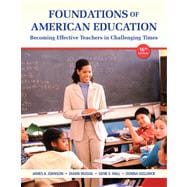NOTE: Used books, rentals, and purchases made outside of Pearson
If purchasing or renting from companies other than Pearson, the access codes for the Enhanced Pearson eText may not be included, may be incorrect, or may be previously redeemed. Check with the seller before completing your purchase.
This package includes the Enhanced Pearson eText with MyEducationLab and the bound book.
The new Sixteenth Edition of this classic text presents a broad introduction to the foundations of education through discussion of theory and practice in such areas as advocacy; legislation; and the current social, political, and economic climate. In it, teachers gain a realistic perspective and approach to their work. Current, thoughtful, and completely up-to-date, Foundations of American Education presents a comprehensive look at the fast-paced world of information and the underlying constructs influencing today’s schools. The book includes comprehensive coverage of recent trends and issues in schools, the emergence of Common Core State Standards, RTI, and the continuing emphasis on assessment. The Enhanced Pearson eText features embedded video.
Improve mastery and retention with the Enhanced Pearson eText*
The Enhanced Pearson eText provides a rich, interactive learning environment designed to improve student mastery of content. The Enhanced Pearson eText is:
- Engaging. The new interactive, multimedia learning features were developed by the authors and other subject-matter experts to deepen and enrich the learning experience.
- Convenient. Enjoy instant online access from your computer or download the Pearson eText App to read on or offline on your iPad® and Android® tablet.*
- Affordable. The Enhanced Pearson eText may be purchased stand-alone or with a loose-leaf version of the text for 40-65% less than a print bound book.
* The Enhanced eText features are only available in the Pearson eText format. They are not available in third-party eTexts or downloads.
*The Pearson eText App is available on Google Play and in the App Store. It requires Android OS 3.1-4, a 7” or 10” tablet, or iPad iOS 5.0 or later.
- 0132836726 / 9780132836722Foundations of American Education: Becoming Effective Teachers in Challenging Times
- 0132943522 / 9780132943529NEW MyEducationLab with Video-Enhanced Pearson eText -- Standalone Access Card -- for Foundations of American Education: Becoming Effective Teachers in Challenging Times








